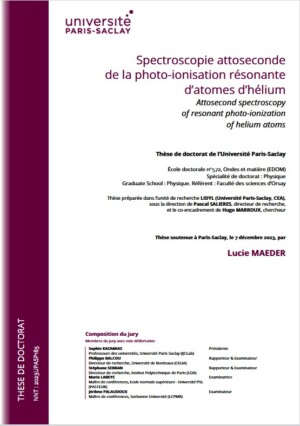Thesis manuscript
This thesis deals with the study of ultrafast photo-induced processes in atoms on the attosecond time scale (1as = 10-18s). The aim was to resolve the electronic dynamics of the resonant photoionization process in both space and time.
To this end, work focused on the study of 2-photon ionization (XUV IR) of helium through bound states close to the 1sNp ionization threshold (N=3,4,5,6). The electronic dynamics of ionization were resolved temporally and spatially by combining an electron wave packet interferometry technique with angularly resolved photoelectron spectroscopy. The resonant 2-photon transition was probed using two different interferometric schemes.
In the first scheme, called RABBIT, the resonant electron wave packet (EWP) was characterized through its interference with a second non-resonant 2-photon EWP used as a reference. The 3D spatial structure of the POE was reconstructed, along with its temporal evolution. Transient trapping on the bound states induces a delay in POE emission, and its spatial structure is preserved throughout the photoemission dynamics.
The second interferometric scheme used in this thesis provides direct access to the 2-photon transition dynamics of resonant POE. It is based on interference between the resonant POE and that resulting from two sequential 1-photon transitions. The latter exhibits a slow phase spectral evolution, making it an ideal reference. This scheme was used to characterize POE dynamics for all 1sNp intermediate states, thus extending the previous study. Photoemission dynamics and spatial dependence have been characterized, and the results are consistent with the first scheme for the 1s3p and 1s4p states. This second scheme offers absolute spectral calibration, better spectral resolution and higher sensitivity than the RABBIT scheme.
Keywords: Attosecond, Electronic dynamics, Spectroscopy, Photoionization.
This document may be required for access to the site’
Join Zoom Reunion : https://cnrs.zoom.us/j/99301114679?pwd=MHNDQVVYT1dHM2FQdndTNWFNTWNjQT09
Meeting ID: 993 0111 4679 – Secret code: 5ckkgZ
LIDYL/ATTO
Spectroscopie attoseconde de la photoionisation résonante d’atomes d’hélium
Manuscrit de la thèse
Résumé :
Cette thèse porte sur l’étude de processus ultrarapides photo-induits dans les atomes à l’échelle de temps attoseconde (1as = 10-18s). L’objectif était de résoudre la dynamique électronique du processus de photoionisation résonante à la fois dans l’espace et dans le temps.
Pour ce faire, les travaux ont porté sur l’étude de l’ionisation à 2-photons (XUV+IR) de l’hélium à travers des états liés proches du seuil d’ionisation 1sNp (N=3,4,5,6). La dynamique électronique d’ionisation a été résolue temporellement et spatialement en associant une technique d’interférométrie de paquets d’onde électronique à la spectroscopie de photoélectrons résolue angulairement. La transition à 2-photons résonante a été sondée en utilisant deux schémas interférométriques différents.
Dans le premier schéma, appelé RABBIT, le paquet d’onde électronique (POE) résonant a été caractérisé à travers son interférence avec un second POE à 2-photons non-résonant utilisé comme référence. La structure spatiale 3D du POE a pu être reconstruite ainsi que son évolution temporelle. Le piégeage transitoire sur les états liés induit un retard de l’émission du POE et sa structure spatiale est conservée durant toute la dynamique de photoémission.
Le second schéma interférométrique utilisé dans cette thèse permet un accès direct à la dynamique de transition à 2-photon du POE résonant. Celui-ci s’appuie sur l’interférence entre le POE résonant et celui résultant de deux transitions à 1-photon séquentielles. Ce dernier présente une évolution spectrale de la phase lente et constitue alors une référence idéale. Ce schéma a été utilisé pour caractériser la dynamique du POE pour tous les états intermédiaires 1sNp, prolongeant ainsi l’étude précédente. La dynamique de photoémission et la dépendance spatiale ont été caractérisées et les résultats sont consistants avec le premier schéma pour les états 1s3p et 1s4p. Ce second schéma présente une calibration spectrale absolue, une meilleure résolution spectrale, ainsi qu’une meilleure sensibilité que le schéma RABBIT.
Mots-clés : Photoionisation, Attoseconde, Dynamiques électroniques, Spectroscopie.



